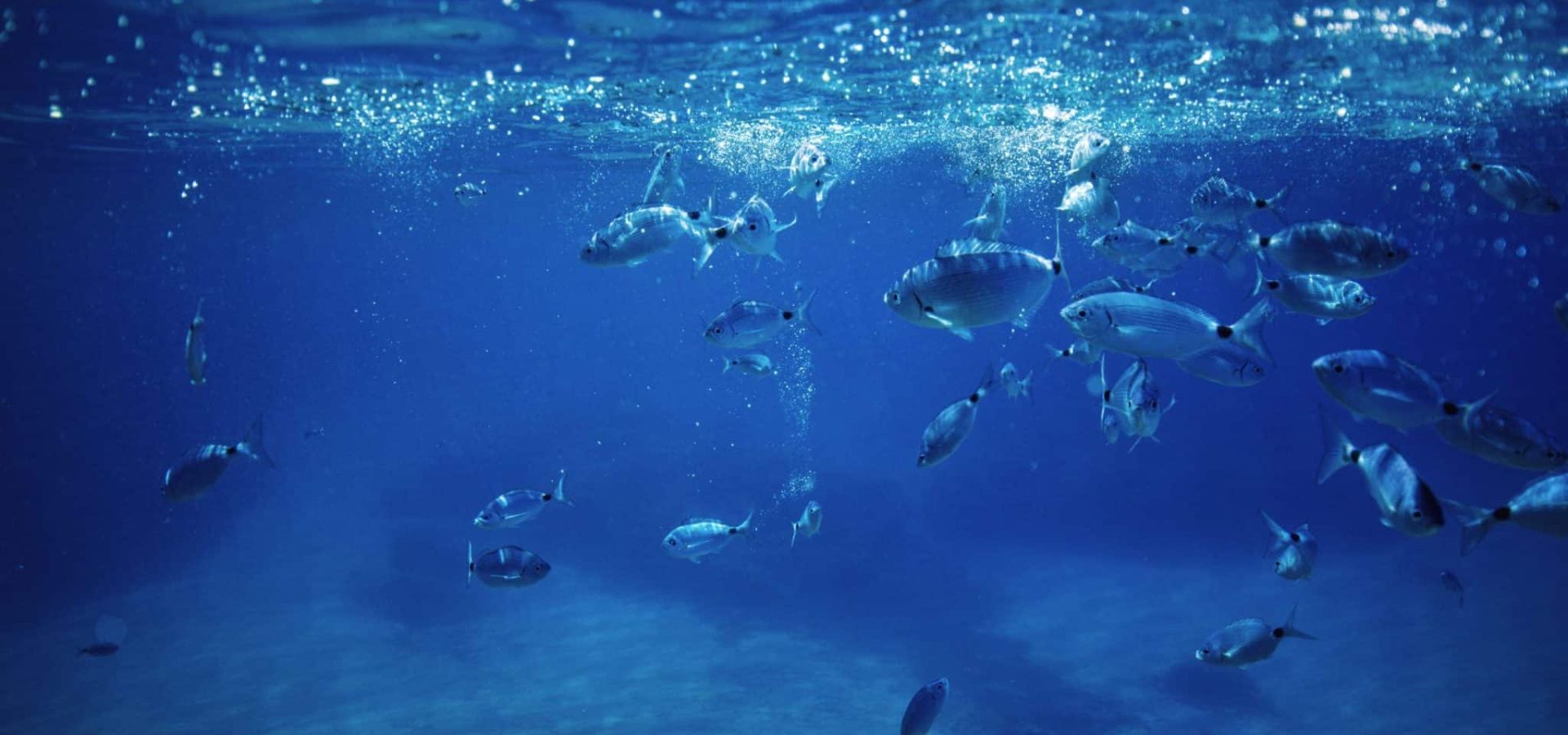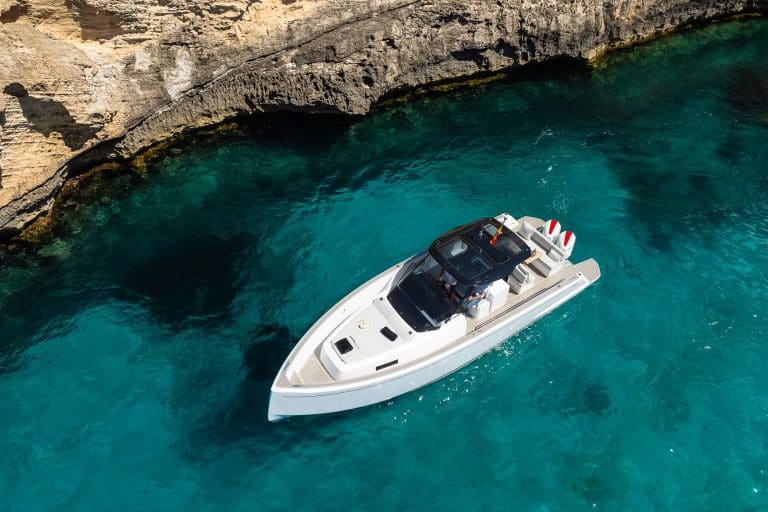The Mediterranean Sea is one of the seas of the Atlantic Ocean connected through the Strait of Gibraltar. It is characterised by a high degree of endemic species, making it one of the most biodiverse places in the world. The fish of the Mediterranean Sea are abundant and diverse. The water temperature varies according to the season, between 21º and 30º in summer and between 10º and 15º in winter.
The Mediterranean Sea is the deepest enclosed sea on Earth, with an average depth of 1,460m and a maximum depth of 5,267m. In fact, the deepest part is off the coast of Greece, in the Matapan Trench, and reaches a depth of over 5,000m.
To date, around 17,000 species have been recorded in the Mediterranean Sea, of which around 25.6% are molluscs and crustaceans and only 4.1% are vertebrates or fish. There are different ways to classify them, for example by their diet, by their shape and by their habitat – on the surface or on the bottom (pelagic, demersal, benthic…).

Meet some of the most famous types of fish from the Mediterranean Sea.
To keep it simple, we are going to distinguish them into two main categories: sea fish and rock fish. Sea fish tend to swim in open waters and tend to be migratory species such as bluefin tuna, amberjack, John Dory… However, where we really find the greatest diversity is in rockfish, which are found or live around rocks, caves and rocky seabeds.
- Grouper (Epinephelus marginatus):
The maximum size of the grouper is 1.5 metres and it can weigh up to 70 kilos. Adult grouper can be found at a depth of 20 metres and juveniles can be found at a depth of 2 to 3 metres.
- Sea bass (Dicentrarchus labrax):
The maximum size of the sea bass is 1 metre and it can weigh up to 7 kilos. It can be found at a depth of a few metres, at a maximum of 5 metres.
- Corvina (Argyrosomus regius):
The maximum size of the corvina is 2 metres and it can weigh up to 50 kilos. It can be found at a depth of a few metres, at a maximum depth of 200 metres.
- Hake
They can reach 140 cm in length, although they do not usually exceed 70 cm. It is worth noting that its weight can reach 15 kg and it lives between 30 and 500 m deep, approaching the coast in the summer months.
- Conger conger (Conger conger):
The maximum size of the conger conger is 3 metres and it can weigh up to 40 kilos. They can be found from a few metres down to 200 metres.
- Sea bream (Diplodus sargus):
The maximum size of the bream is 45 centimetres and it can weigh up to 1 kilo. They can be found at depths of between 2 and 80 metres.
- Bluefin tuna (Thunnus thynnus)
The Atlantic bluefin tuna can grow to more than 3 metres in length and can weigh up to 700 kilos. They are normally found in cold waters, but due to their migrations they can also be found in the warm waters of the Mediterranean Sea.
- Sea bream (Pagellus Bogaraveo)
The bream has an average size of 35 cm in length. The youngest live close to the shore, while the adults go to depths between 100 m and 400 m.
- Sardine (Sardina Pilchardus)

Sardine
Sardines are a pelagic species, aggregating in large schools, and live between the surface and 150 metres.
- Frigate tuna (Auxis thazard thazard)
This is a pelagic species that swims in mid-water and is found at depths ranging from the surface to 200 metres offshore. The frigate tuna can measure up to 68 cm.
Would you like to know which ones are the most feared? Find out below…
- Scorpion fish or spider fish (Echiichthys vipera)
The well-known spiderfish is a bony fish (Osteichthyes) with an elongated shape belonging to the Perciformes group and the family Trachinidae. It is about 30 cm long and usually lives in cold Mediterranean waters. Its most characteristic feature is its venomous spines pointing backwards. However, there are also some non-venomous spiderfishes, which can be distinguished by looking at the first dorsal fin, as the venomous ones have a short, black one.
This fish hides in the sand waiting for prey, so it is easy to accidentally step on it. Its bite can cause swelling, vomiting, pain, fever, respiratory failure and convulsions.
 Spiderfish, source: https://www.fishipedia.es/
Spiderfish, source: https://www.fishipedia.es/
- Portuguese Caravel (Physalia physalis)
This is a floating colonial animal, i.e. a colony of organisms that associate in order to survive, with polyps of quite different shapes and functions (reproductive, digestive, etc.). It has a gas float that allows it to drift, through currents or thanks to the wind, on the surface of the sea.
The venom of its tentacles, up to 10 m long, has neurotoxic, cytotoxic and cardiotoxic properties. It can cause burning, pain and, in some cases, more serious consequences.
- Stonefish (Synanceia verrucosa)
This marine species is commonly known as “stonefish” because it resembles a rock, and can camouflage itself perfectly in rocks. It is the second largest fish in the world, behind the whale shark, and frequents the Mediterranean Sea, although it mainly inhabits places such as Australia, the Philippines, and Indonesia.
The stonefish is considered the most dangerous marine animal in the world, along with all species of the genus Synanceia, as it is equipped with spines that release neurotoxins capable of causing temporary paralysis, tissue inflammation, shock, cardiorespiratory arrest… If the bite is not treated immediately, the person can die in a matter of minutes.
- Mediterranean moray eel (Muraena helena)

More from the Mediterranean, source: https://es.wikipedia.org/
It is a fish with an elongated and compressed body, similar to the appearance of a snake, a large mouth with sharp teeth. It generally lives among the rocks, up to 100 m deep, and can reach a length of 1.5 m and a weight of 15 kg.
Mediterranean moray eels are solitary, very territorial and carry out most of their predatory activity at night. Although harmless if left undisturbed, their bite can be dangerous to humans and can even tear off a person’s fingers.
- Mediterranean torpedo
This fish comes from the ray family and can reach a size of up to 70 cm. Its body is characterised by a flattened, almost circular shape and a strong tail. It usually inhabits sandy beds close to the shore and can swim at depths of up to 100 m.
The torpedo boat has a very particular way of defending itself against predators by producing electric shocks of up to 220 volts. In fact, a single electric shock to a human can render it unconscious.
In short, wherever you go in the Mediterranean Sea, you will find all kinds of fish and marine species. Take advantage of any nautical outing to discover the wonders that our beloved Mare Nostrum has to offer.








